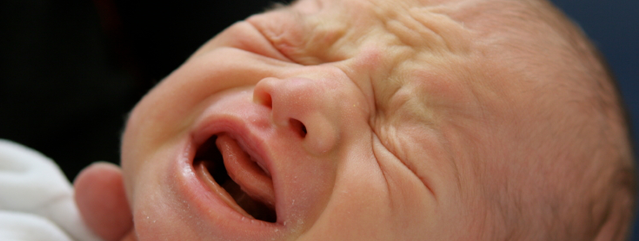Newborns Do Feel Pain
Luis Grenada, a 16th century theologian, would probably not care whether or not newborns feel pain, for he called them “a lower animal in human form.” And during the early 20th century, the ignorance of the times drove researchers to stick newborns with pins, even while they were asleep, to determine whether or not they sensed pain. Their defensive frantic kicking apparently was not adequate proof. More studies were undertaken, more pinpricks. Because the newborns reacted with what one researcher called “diffuse bodily movements accompanied by crying,” she determined that they had “limited sensitivity to pain” (http://www.nocirc.org/symposia/second/chamberlain.html). But did these researchers take into consideration that mothers might have received anesthesia during labor, effecting newborns’ response to painful stimuli?
A 2011 British study concluded that the sensation of pain starts before birth, between 35 and 37 weeks gestation (http://www.livescience.com/15975-babies-feeling-pain.html). Continually sticking newborns with pins merely to prove they feel pain is unnecessary, and cruel. As a neonatal intensive care nurse, my job, unfortunately, required me to poke babies’ heels for blood samples – I don’t need to share with you the more than unpleasant experiences.
Newborns may experience pain from surgery, and discomfort from the various tubes inserted into their bodies. Male newborns undoubtedly feel pain when circumcised. Dozens of studies, in which researchers have measured cortisol levels in babies, have proven so. They noted that this stress hormone increased as high as four times the levels prior to circumcisions (http://www.circumcision.org/response.htm).
So, if you’re a novice neonatal nurse, or a first time parent, here’s clear evidence that a newborn is experiencing pain:
Crying: At one time, people believed newborn cries were not purposeful sounds, but random noises. But when a newborn cries, I mean wails, his breath cut short, his face turning the color of an eggplant, you know he needs more than his diaper changed. With prolonged crying, newborns may turn cyanotic, or blue, from decreased oxygen levels.
Facial expressions: furrowed eyebrows with eyes squeezed shut. You might also notice their chins quivering.
Body Language: Kicking. Clenched fists. Flailing – arms and legs pulled in then stretched out. Premature babies often become quite and still, or floppy when in pain.
Vital signs: Increased heart rate and blood pressure. Decreased oxygen levels. A change in vital signs are particularly helpful when assessing premature or ill newborns in pain, as they do not have the energy to cry or flail like healthy newborns.
To help determine appropriate intervention, it’s common practice for nurses to score newborns’ discomfort (http://www.vuneo.org/nppainass.htm).
But how do you relieve newborns’ pain? If you’re a neonatal nurse, and the source of pain is evident – the newborn just woke up from abdominal surgery for instance – administration of narcotics might be warranted. Parents might worry that their newborns will become addicted to pain medication, but allowing babies to endure unnecessary pain comes with consequences: difficulty sleeping and eating, and physiological and structural changes in the nervous system. Babies might become hypersensitive to pain during future procedures (http://www.ncbi.nlm.nih.gov/pubmed/12391738). Different from addiction – a psychological issue – babies can become physically dependent on pain medication. To avoid withdrawal symptoms, nurses slowly wean them off medication.
Swaddling, breastfeeding, skin-to-skin contact with parents, sucking on a pacifier, and infant massage can also alleviate newborn discomfort (http://www.parents.com/baby/care/newborn/how-to-massage-baby).


Recent Comments